
The last survivor of the original Mercury 7 astronauts was 95. Glenn died at the James Cancer Hospital in Columbus, Ohio, where he was hospitalized for more than a week, said Hank Wilson, communications director for the John Glenn School of Public Affairs.
Politicians, astronauts, educators and others repeatedly called him a hero with many mentioning the phrase that first sent him into orbit: “Godspeed, John Glenn.”
A compilation of reactions from around the nation is included at the end of this report.
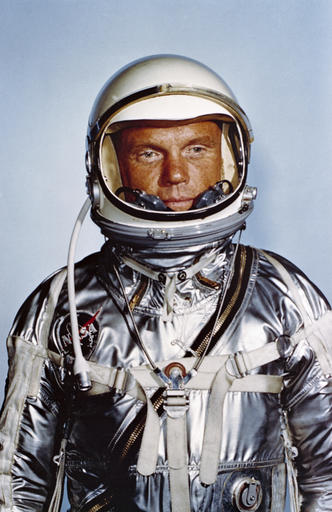
Utah Sen. Orrin Hatch noted in his comments that “America has lost a hero, and I have lost a dear friend.”
“As an astronaut, John captured our imaginations with his courage and resourcefulness during his pioneering spaceflight. As a patriot, he answered the call of public service, becoming a voice of reason and a champion of bipartisanship in the Senate,” Hatch stated in a press release.
“From his iconic voyages into the final frontier to his numerous achievements in government, John leaves to a grateful nation a legacy that ranks among the greatest of his era,” Hatch said. “Elaine and I send our thoughts and prayers to his beloved wife Annie and the entire Glenn family during this difficult time.”
John Herschel Glenn Jr. had two major career paths that often intersected: flying and politics, and he soared in both of them.
Before he gained fame orbiting the world, he was a fighter pilot in two wars, and as a test pilot he set a transcontinental speed record. He later served 24 years in the Senate from Ohio. A rare setback was a failed 1984 run for the Democratic presidential nomination.
His long political career enabled him to return to space in the shuttle Discovery at age 77 in 1998, a cosmic victory lap that he relished and turned into a teachable moment about growing old. He holds the record for the oldest person in space.
More than anything, Glenn was the ultimate and uniquely American space hero: a combat veteran with an easy smile, a strong marriage of 70 years and nerves of steel. Schools, a space center and the Columbus airport were named after him. So were children.
The Soviet Union leaped ahead in space exploration by putting the Sputnik 1 satellite in orbit in 1957, and then launched the first man in space, cosmonaut Yuri Gagarin, in a 108-minute orbital flight on April 12, 1961. After two suborbital flights by Alan Shepard Jr. and Gus Grissom, it was up to Glenn to be the first American to orbit the Earth.
“Godspeed, John Glenn,” fellow astronaut Scott Carpenter radioed just before Glenn thundered off a Cape Canaveral launch pad, now a National Historic Landmark, to a place America had never been. At the time of that Feb. 20, 1962, flight, Glenn was 40 years old.
With the all-business phrase, “Roger, the clock is operating, we’re underway,” Glenn radioed to Earth as he started his 4 hours, 55 minutes and 23 seconds in space. Years later, he explained he said that because he didn’t feel like he had lifted off and it was the only way he knew he had launched.
During the flight, Glenn uttered a phrase that he would repeat frequently throughout life: “Zero G, and I feel fine.”
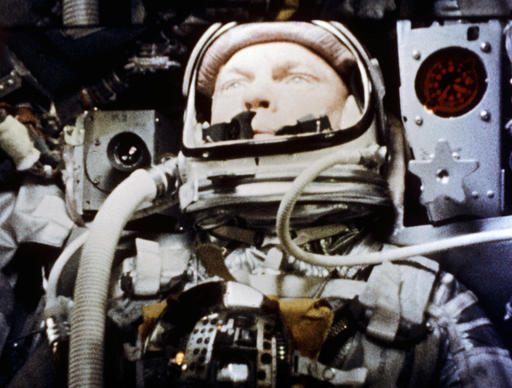
“It still seems so vivid to me,” Glenn said in a 2012 interview with The Associated Press on the 50th anniversary of the flight. “I still can sort of pseudo feel some of those same sensations I had back in those days during launch and all.”
Glenn said he was often asked if he was afraid, and he replied, “If you are talking about fear that overcomes what you are supposed to do, no. You’ve trained very hard for those flights.”
Glenn’s ride in the cramped Friendship 7 capsule had its scary moments, however. Sensors showed his heat shield was loose after three orbits, and Mission Control worried he might burn up during re-entry when temperatures reached 3,000 degrees. But the heat shield held.
Even before then, Glenn flew in dangerous skies. He was a fighter pilot in World War II and Korea who flew low, got his plane riddled with bullets, flew with baseball great Ted Williams and earned macho nicknames during 149 combat missions. And as a test pilot he broke aviation records.
The green-eyed, telegenic Marine even won $25,000 on the game show “Name That Tune” with a 10-year-old partner. And that was before April 6, 1959, when his life changed by being selected as one of the Mercury 7 astronauts and instantly started attracting more than his share of the spotlight.
Glenn in later years regaled crowds with stories of NASA’s testing of would-be astronauts, from psychological tests — come with 20 answers to the open-ended question “I am” — to surviving spinning that pushed 16 times normal gravity against his body, popping blood vessels.
But it wasn’t nearly as bad as coming to Cape Canaveral to see the first unmanned rocket test.
“We’re watching this thing go up and up and up … and all at once it blew up right over us, and that was our introduction to the Atlas,” Glenn said in 2011. “We looked at each other and wanted to have a meeting with the engineers in the morning.”
In 1959, Glenn wrote in Life magazine: “Space travel is at the frontier of my profession. It is going to be accomplished, and I want to be in on it. There is also an element of simple duty involved. I am convinced that I have something to give this project.”
That sense of duty was instilled at an early age. Glenn was born July 18, 1921, in Cambridge, Ohio, and grew up in New Concord, Ohio, with the nickname “Bud.”
He joined the town band as a trumpeter at age 10 and accompanied his father one Memorial Day in an echoing version of “Taps.” In his 1999 memoir, Glenn wrote “that feeling sums up my childhood. It formed my beliefs and my sense of responsibility. Everything that came after that just came naturally.”
His love of flight was lifelong; John Glenn Sr. spoke of the many summer evenings he arrived home to find his son running around the yard with outstretched arms, pretending he was piloting a plane.
Last June, at a ceremony renaming the Columbus airport for him, Glenn recalled imploring his parents to take him to that airport to look at planes whenever they passed through the city: “It was something I was fascinated with.” He piloted his own private plane until age 90.
Glenn’s goal of becoming a commercial pilot was changed by World War II. He left Muskingum College to join the Naval Air Corps and soon after, the Marines.
He became a successful fighter pilot who ran 59 hazardous missions, often as a volunteer or as the requested backup of assigned pilots. A war later, in Korea, he earned the nickname “MiG-Mad Marine” (or “Old Magnet A — ,” which he sometimes paraphrased as “Old Magnet Tail.”)
“I was the one who went in low and got them,” Glenn said, explaining that he often landed with huge holes in the side of his aircraft because he didn’t like to shoot from high altitudes.
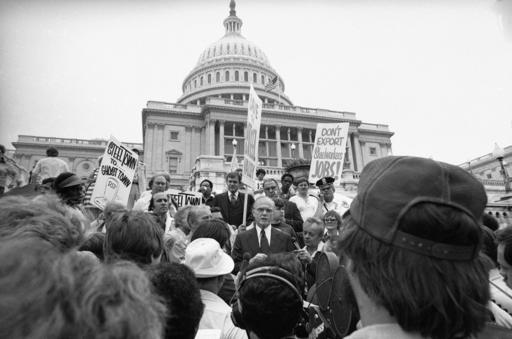
Glenn’s public life began when he broke the transcontinental airspeed record, bursting from Los Angeles to New York City in three hours, 23 minutes and 8 seconds.
With his Crusader averaging 725 mph, the 1957 flight proved the jet could endure stress when pushed to maximum speeds over long distances.
In New York, he got a hero’s welcome — his first tickertape parade. He got another after his flight on Friendship 7.
That mission also introduced Glenn to politics. He addressed a joint session of Congress, and dined at the White House.
He became friends with President Kennedy and ally and friend of his brother Robert. The Kennedys urged him to enter politics, and after a difficult few starts he did.
Glenn spent 24 years in the U.S. Senate, representing Ohio longer than any other senator in the state’s history. He announced his impending retirement in 1997, 35 years to the day after he became the first American in orbit, saying, “There is still no cure for the common birthday.”
Glenn returned to space in a long-awaited second flight in 1998 aboard the space shuttle Discovery. He got to move around aboard the shuttle for far longer — nine days compared with just under five hours in 1962 — as well as sleep and experiment with bubbles in weightlessness.
In a news conference from space, Glenn said, “To look out at this kind of creation out here and not believe in God is to me impossible.”
NASA tailored a series of geriatric-reaction experiments to create a scientific purpose for Glenn’s mission, but there was more to it than that: a revival of the excitement of the earliest days of the space race, a public relations bonanza and the gift of a lifetime.
“America owed John Glenn a second flight,” NASA Administrator Dan Goldin said.
Glenn would later write that when he mentioned the idea of going back into space to his wife, Annie, she responded: “Over my dead body.”
Glenn and his crewmates flew 3.6 million miles, compared with 75,000 miles aboard Friendship 7.
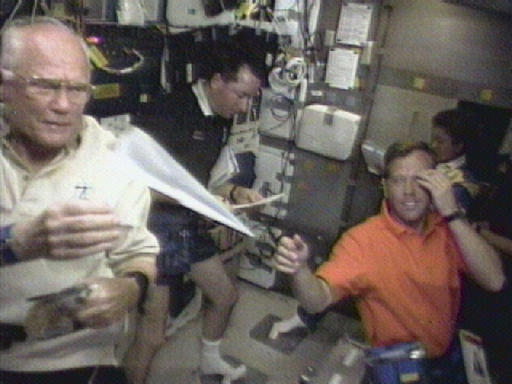
Shortly before he ran for the 1984 Democratic presidential nomination, a new generation was introduced to astronaut Glenn with the film adaptation of Tom Wolfe’s book “The Right Stuff.” He was portrayed as the ultimate straight arrow amid a group of hard-partying astronauts.
Glenn said in 2011: “I don’t think any of us cared for the movie ‘The Right Stuff’; I know I didn’t.”
Glenn was unable to capitalize on the publicity, though, and his poorly organized campaign was short-lived. He dropped out of the race with his campaign $2.5 million in the red — a debt that lingered even after he retired from the Senate in 1999.
He later joked that except for going into debt, humiliating his family and gaining 16 pounds, running for president was a good experience.
Glenn generally steered clear of campaigns after that, saying he didn’t want to mix politics with his second space flight.
He sat out the Senate race to succeed him — he was hundreds of miles above Earth on Election Day — and largely was quiet in the 2000 presidential race.
He first ran for the Senate in 1964 but left the race when he suffered a concussion after slipping in the bathroom and hitting his head on the tub.
He tried again in 1970 but was defeated in the primary by Howard Metzenbaum, who later lost the general election to Robert Taft Jr. It was the start of a complex relationship with Metzenbaum, whom he later joined in the Senate.
For the next four years, Glenn devoted his attention to business and investments that made him a multimillionaire. He had joined the board of Royal Crown Cola after the aborted 1964 campaign and was president of Royal Crown International from 1967 to 1969. In the early 1970s, he remained with Royal Crown and invested in a chain of Holiday Inns.
In 1974, Glenn ran against Metzenbaum in what turned into a bitter primary and won the election. He eventually made peace with Metzenbaum, who won election to the Senate in 1976.
Glenn set a record in 1980 by winning re-election with a 1.6 million vote margin.
He became an expert on nuclear weaponry and was the Senate’s most dogged advocate of nonproliferation. He was the leading supporter of the B-1 bomber when many in Congress doubted the need for it. As chairman of the Governmental Affairs Committee, he turned a microscope on waste and fraud in the federal bureaucracy.
Glenn said the lowest point of his life was 1990, when he and four other senators came under scrutiny for their connections to Charles Keating, the notorious financier who eventually served prison time for his role in the costly savings and loan failure of the 1980s. The Senate Ethics Committee cleared Glenn of serious wrongdoing but said he “exercised poor judgment.”
The episode was the only brush with scandal in his long public career and didn’t diminish his popularity in Ohio.
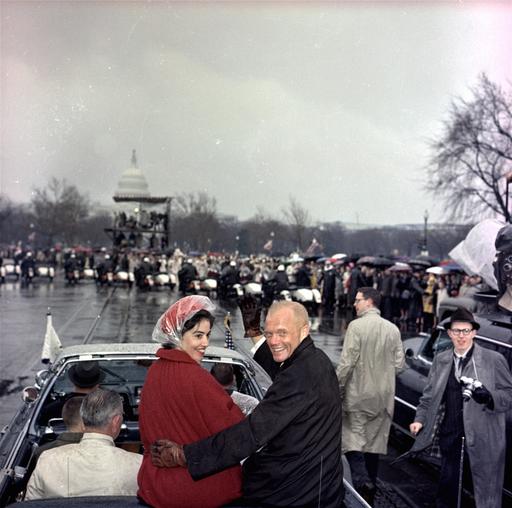
Glenn joked that the only astronaut he was envious of was his fellow Ohioan: Neil Armstrong, the first man to walk on the moon.
“I’ve been very fortunate to have a lot of great experiences in my life and I’m thankful for them,” he said in 2012.
In 1943, Glenn married his childhood sweetheart, Anna Margaret Castor.
They met when they were toddlers, and when she had mumps as a teenager, he came to her house, cut a hole in her bedroom window screen, and passed her a radio to keep her company, a friend recounted.
“I don’t remember the first time I told Annie I loved her, or the first time she told me,” Glenn would write in his memoir. “It was just something we both knew.”
He bought her a diamond engagement ring in 1942 for $125. It’s never been replaced.
They had two children, Carolyn and John David. He and his wife, Annie, split their later years between Washington and Columbus. Both served as trustees at their alma mater, Muskingum College.
Glenn spent time promoting the John Glenn School of Public Affairs at Ohio State University, which also houses an archive of his private papers and photographs.
More information about Glenn’s life can be found online at The John and Annie Glenn Museum.
Here is a look at reactions to Glenn’s death, gathered by the Associated Press:
- “When John Glenn blasted off from Cape Canaveral atop an Atlas rocket in 1962, he lifted the hopes of a nation. And when his Friendship 7 spacecraft splashed down a few hours later, the first American to orbit the Earth reminded us that with courage and a spirit of discovery there’s no limit to the heights we can reach together. … The last of America’s first astronauts has left us, but propelled by their example we know that our future here on Earth compels us to keep reaching for the heavens. On behalf of a grateful nation, Godspeed, John Glenn.” — President Barack Obama
- “Today we lost a great pioneer of air and space in John Glenn. He was a hero and inspired generations of future explorers. He will be missed.” — President-elect Donald Trump, on Twitter.
- “Glenn’s extraordinary courage, intellect, patriotism and humanity were the hallmarks of a life of greatness. His missions have helped make possible everything our space program has since achieved and the human missions to an asteroid and Mars that we are striving toward now.” — NASA Administrator Charles Bolden.
- “The Corps lost a legend today. Col. John Glenn — an astronaut, a senator, a Marine — died at the age of 95. Semper Fi, Sir.” — U.S. Marine Corps, on its Twitter account.
- “May his memory live on every time we look up at the stars.” — U.S. House Speaker Paul Ryan, R-Wis.
- “On top of paving the way for the rest of us, he was also a first-class gentleman and an unabashed patriot.” — U.S. Sen. Bill Nelson, D-Fla., who also flew in space.
- “Today our nation bids farewell to one of the most iconic figures of the 20th Century. John Glenn said his childhood was like something out of a Norman Rockwell painting, but his life was anything but typical.” — U.S. Senate Majority Leader Mitch McConnell, R-Ky.
- “You look at John Glenn and his is really a life of service and we don’t see enough of that. He is an honest-to-God hero in all kinds of ways.” — Roger Launius, National Air and Space Museum associate director and historian.
- “John Glenn is, and always will be, Ohio’s ultimate hometown hero, and his passing today is an occasion for all of us to grieve. … Though he soared deep into space and to the heights of Capitol Hill, his heart never strayed from his steadfast Ohio roots. Godspeed, John Glenn!” — Ohio Gov. John Kasich
- “The Ohio State University community deeply mourns the loss of John Glenn, Ohio’s consummate public servant and a true American hero. He leaves an undiminished legacy as one of the great people of our time.” — Ohio State President Michael Drake
- “What made John Glenn a great senator was the same quality that made him a great astronaut and an iconic American hero: He saw enormous untapped potential in the nation he loved and he had faith that America could overcome any challenge.” — U.S. Sen. Sherrod Brown, D-Ohio
- “John Glenn was an American hero. He flew 149 combat missions in two wars. He was the first American to orbit the Earth, and the longest-serving United States Senator in Ohio history.” — Sen. Rob Portman, R-Ohio
- “John Glenn’s enduring commitment to public service, devoted patriotism, and tremendous courage embody the very best of the American spirit. John’s passionate belief that everyone has an obligation to serve has inspired many people across America to contribute to their communities.” — House Minority Leader Nancy Pelosi, D-Calif.
- “No one in this country epitomized the nobility and patriotism of public service more than Ohio’s John Glenn.” — Ohio Democratic Party Chairman David Pepper.
Click on photo to enlarge it, then use your left-right arrow keys to cycle through the gallery.

In this Feb. 20, 1962 photo made available by NASA, astronaut John Glenn pilots the "Friendship 7" Mercury spacecraft during his historic flight as the first American to orbit the Earth. Glenn, who later spent 24 years representing Ohio in the Senate, has died at 95. (NASA via AP)

FILE - In this Sunday, Nov. 1, 1998 image made from video, astronaut John Glenn, left, retrieves a paper airplane for pilot Steven Lindsey, foreground right, in the space shuttle Discovery's middeck. Astronaut Stephen Robinson, background right, and Japanese astronaut Chiaki Mukai look over paper work in the background. Glenn died Thursday, Dec. 8, 2016, at the age of 95. (AP Photo/NASA, File)

FILE - In this Feb. 20, 2012, file photo, U.S. Sen. John Glenn talks with astronauts on the International Space Station via satellite before a discussion titled "Learning from the Past to Innovate for the Future" in Columbus, Ohio. Glenn, who was the first U.S. astronaut to orbit Earth and later spent 24 years representing Ohio in the Senate, has died at 95. (AP Photo/Jay LaPrete, File)

FILE - In this Feb. 26, 1962 file photo, Mercury astronaut John Glenn, and his wife, Annie, ride in the back of an open car with Vice-President Johnson during a parade in Glenn's honor in Washington. The Capitol is seen in the background. Glenn, the first American to orbit Earth who later spent 24 years representing Ohio in the Senate, died Thursday, Dec. 8, 2016, at the age of 95. (AP Photo/File)

FILE - In this Friday, Aug. 29, 2008 file photo, astronauts Neil Armstrong, left, the first man to walk on the moon, John Glenn Jr., center, the first American to orbit earth, and James Lovell, right, commander of Apollo 13, stand at a gathering of 19 of the astronauts who call Ohio home in Cleveland. The gathering of Ohio astronauts was part of NASA's 50th Anniversary celebration. Glenn died Thursday, Dec. 8, 2016, at the age of 95. (AP Photo/Jason Miller, File)

FILE - In this Friday, Sept. 23, 1977 file photo, Sen. John Glenn, D-Ohio, center, speaks to a group of Youngstown, Ohio Steelworkers on the steps of the Capitol in Washington. The group urged the government to curb steel imports and to relax pollution control requirements. Glenn, the first U.S. astronaut to orbit Earth who later spent 24 years representing Ohio in the Senate, died Thursday, Dec. 8, 2016, at the age of 95. (AP Photo/Harvey Georges, File)

FILE - In this Feb. 20, 1962, file photo, astronaut John Glenn sits next to the Friendship 7 space capsule atop an Atlas rocket at Cape Canaveral, Fla., during preparations for his flight which made him the first American to orbit the Earth. Glenn, who later spent 24 years representing Ohio in the Senate, has died at 95. (AP Photo/File)

In this February 1962 photo made available by NASA, astronaut John Glenn looks into a Celestial Training Device globe at the Aeromedical Laboratory at Cape Canaveral, Fla. Glenn, the first American to orbit Earth who later spent 24 years representing Ohio in the Senate, died Thursday, Dec. 8, 2016, at the age of 95. (NASA via AP)

FILE - In this Feb. 23, 1962 file photo, astronaut John Glenn and President John F. Kennedy inspect the Friendship 7, the Mercury capsule in which Glenn became the first American to orbit the Earth. Kennedy presented Distinguished Service medal to Glenn at Cape Canaveral, Fla. At right is Vice President Lyndon Johnson. Glenn, who later spent 24 years representing Ohio in the Senate, has died at 95. (AP Photo/Vincent P. Connolly, File)
Written by SETH BORENSTEIN, AP Science Writer
Email: [email protected]
Twitter: @STGnews
Copyright 2016 The Associated Press. All rights reserved. This material may not be published, broadcast, rewritten or redistributed.

Wow! A life well lived. Can you imagine being born in 1921 not yet knowing while you were growing up that you would be the first man to orbit the moon?
An American hero indeed ! but let’s also remember the ones that gave their lives for the space program. he will be missed R.I P